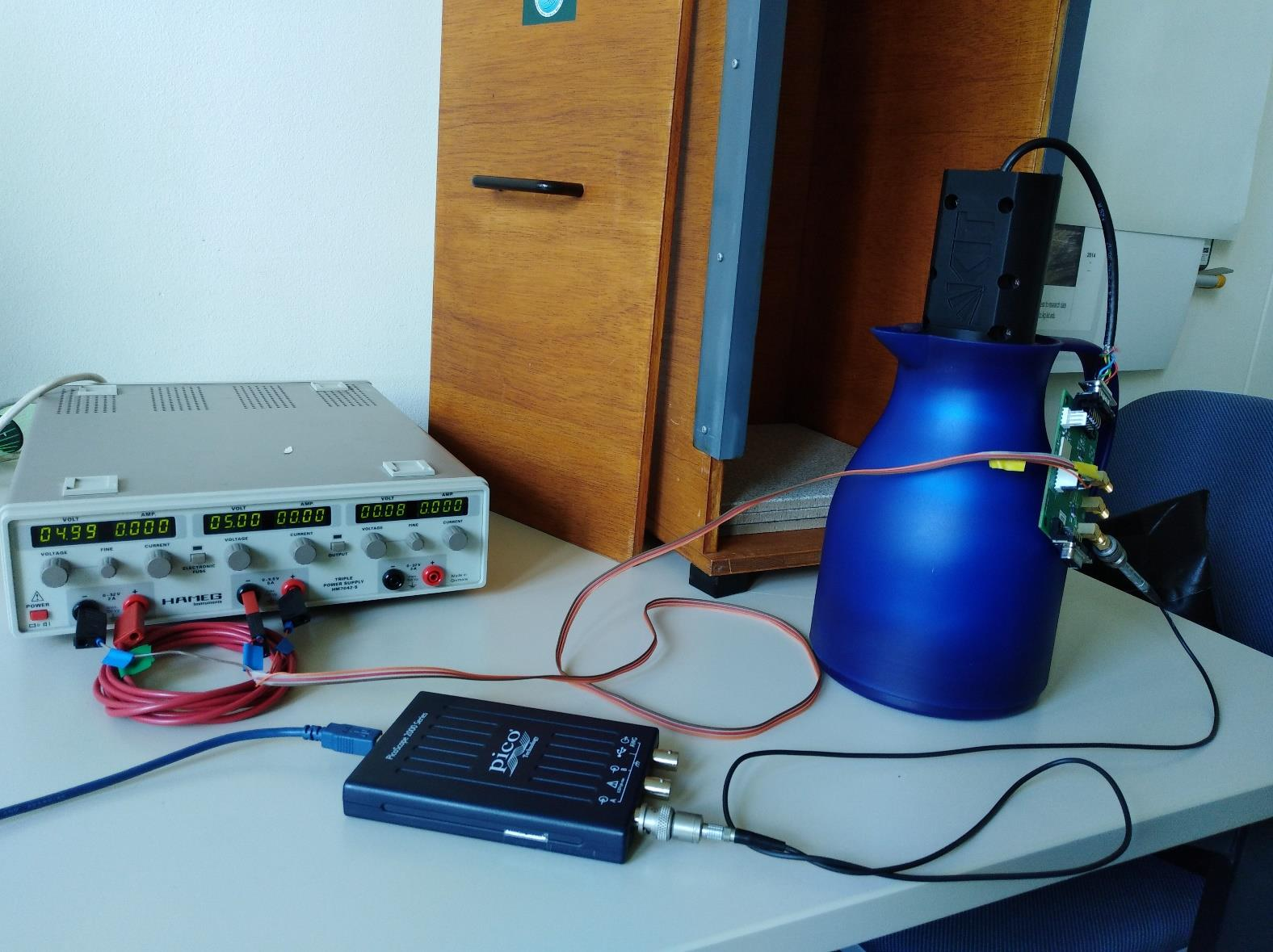
At KIT a students experiments for measuring cosmic muons was developed and produced for training and learning purposes in the context of SENSE: the SiPM Cosmic Can.
With the SiPM Cosmic Can it is possible to measure cosmic muons with a coffe can and a SiPM as detector. The cosmic muons produce Cherenkov light while travelling through the water filled can. Wavelength shifting fibers lead the light to the SiPM which can the be read out using an oscilloscope.
The usage of SiPM instead of PMTs gives students the opportunity to work hands-on with state-of-the-art photosensors and to learn about both, cosmic particles and current detector technology.
A set of ten cans is available for outreach and education events and can be borrowed from KIT. If you are interested, please contact This email address is being protected from spambots. You need JavaScript enabled to view it.
Setup
Below an overview of the setup is shown:

The SiPM Cosmic Can consists of a commercial coffee can, which has to be filled with water. The lid is replaced with a 3D-printed structure holding the fibre bundle and the SiPM. The fibre bundle can be put in and take out to change the fibre configuration. The SiPM, a Hamamatsu S13360-6050PE, is soldered to the so called cookie board together with a resistor and a conductor. With a short cable, to reduce signal loss, the signal goes from the cookie board to the readout board1.
On the readout board the Hamamatsu power supply C11204-02 provides the input power for the SiPM. The power supply is fed by ± 5V input power, and the input voltage for the SiPM is 57V. After a ten times amplification on the readout board the signal can be analysed using any oscilloscope. The can needs to be placed inside a wooden box to reduce background light.
For the measurements of cosmic muons we recommend using a PicoScope which allows the usage of the PicoCosmo software. PicoScope is a USB oscilloscope from PicoTech, available with 2 or 4 channels. The PicoCosmo software was developed for the Kamiokanne and CoSMO students experiments from Netzwerk Teilchenwelt by G. Quast from KIT and is an open source software available from github: https://github.com/GuenterQuast/picoCosmo
It is available for Linux and also runs on a RasperryPi. Either one can be used to perform the measurements and excercises described below.
Measurements
The PicoScope records waveforms which are then analysed with PicoCosmo. First a threshold trigger is applied for one channel. Afterwards the signals for all channels are validated using also the pulse shape. In the next step coincidences between several channels are searched for. Another optional step searches for double pulses caused by decaying muons.
The software provides real-time displays of waveforms, detector signals and rates. Optionally, parameters of identified pulses or of double-pulses are written to files in CSV format. In addition, raw waveforms or pictures in .png format of identified double pulses can optionally be stored for off-line analysis.
Possible Exercises
Basic measurements (high school level):
Rate of cosmic muons: Students could investigate the rate depending on shielding effects of different materials, by e.g. measuring outside and in a cellar room. With two cans also the directional dependence can be investigated.
Detector characteristics: By changing the fibre configuration or by changing the SiPM input voltage the characteristics of the detector can be investigated. Also the dependence of the gain from temperature is an effect that can be investigated using the cans.
Advanced level:
Muon lifetime (knowledge of exponential decay necessary): From the measurement of double pulses the lifetime of a muon can be estimated. These double-pulses occur if the muon decays close to the can an both the muon and the electron from the decay cause a signal in the can.
Other changes in the setup can also be investigated, e.g. exchanging the water with different liquids, measuring without liquids, measuring without fibres, change distance between cans... Here the students are free to make up their own ideas.
SENSE sponsored the production of ten SiPM Cosmic Cans including the cookie and readout board and one 4-channel oscilloscope. This set shall be used for outreach and education events, e.g. for high schools or for practical sessions during summer schools.
If you are interested in borrowing this show-case experiment please contact This email address is being protected from spambots. You need JavaScript enabled to view it.
1The design of the readout board is adopted from the IceScint readout boards which are currently tested at the IceCube detector at the South Pole.

